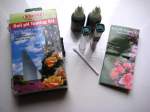Home › Garden soil › Soil identification test
Soil Identification
A Simple 'Feel' Test
Soil identification is one of the first steps towards more successful gardening and you may already have a general idea of the type of soil you have in your own garden.
But have you ever heard other gardeners talking about having a 'sandy loam' or even a 'silty clay loam' and wondered a) what they are talking about, and, b) how on earth they know?
If so, read on...
As we saw in soil basics, the texture of your soil, the relative amounts of sand, clay and silt particles, is the property that determines how it is likely to behave in different conditions.
A clay particle is 1000 times smaller than a grain of sand so the gaps or pore spaces between particles are much smaller in clay-based soils than in sandy ones.
It is these pore spaces that determine how well the soil absorbs air, water and nutrients, how long it retains them, and how quickly they are leached out.
This is why sandy soils, with large pore spaces allowing rapid drainage, tend to dry out quickly and lose nutrients, whilst clay soils, with much smaller pore spaces, retain moisture and are wet and heavy.
So how do you actually work out the relative proportions of sand, silt and clay particles in your own soil?
Of course, simply looking in your garden will help with soil identification. If puddles form on the surface of your soil in wet weather, or cracks appear in very dry weather, you probably have a clay-based soil. A greenish film and surface crusting are typical of silty soils. A loose, fairly even, grainy texture indicates sand. But this doesn't really pin things down.
This is where the soil identification 'Feel Test' comes in. It is very easy, not at all technical, and, even better, will give you a surprisingly accurate result in just a few minutes.
The Soil Identification Feel Test
Working through the steps below will give you a pretty accurate idea of your soil type. The procedure looks complicated but it isn't - just follow the steps (you won't need to do them all) and in a few minutes you will know your soil type. It really is very easy!
Step 1: Prepare your Soil Sample
Take a good handful of soil, about the size of an egg.
- Pick out all the roots, stones, leaves and twigs.
- Moisten the soil evenly working it between your fingers.
Step 2: Test for Sand
Now squeeze it and try to form a ball.
- If it forms a ball carry on to Step 3
- If it falls apart and does not form a ball, you have a result: SAND
Step 3: Test for Clay
Work the soil between your fingers, paying attention to how it feels, and try to roll it into a ribbon.
- If it feels very sticky, is hard to squeeze, stains your hand, forms a shiny surface when rubbed and forms a long (5+ cm) ribbon, it is a type of CLAY. Go to Step 4
- If it is slightly sticky, slightly hard to squeeze and forms a medium (2-5cm) ribbon, it is a type of CLAY LOAM. Go to Step 4
- If it is soft, smooth, easy to squeeze, only slightly sticky at most and forms a short (less than 2 cm) ribbon, it is a type of LOAM. Go to Step 4
- If the soil forms a ball but not a ribbon, go to Step 5
Step 4: Add the Sand and Silt Component to your Classification
Wet a small pinch of soil in your palm and rub it with a forefinger.
- If it feels very gritty, add the word 'Sandy' to your initial classification giving one of the following results: SANDY CLAY; SANDY CLAY LOAM or SANDY LOAM
- If it feels very smooth with no gritty feel, add the word 'Silt' or 'Silty' to your initial classification giving one of the following results: SILTY CLAY; SILTY CLAY LOAM or SILT LOAM
- If it feels only slightly gritty, your original classification is correct and needs no changes, giving one of the following: CLAY; CLAY LOAM or LOAM
Step 5: Test for Loamy Sand or Silt
If the soil forms a ball but not a ribbon and feels:
- Very gritty - you have a result: LOAMY SAND
- Very soft and smooth with no feeling of grittiness - you have a result: SILT
The Next Step...
All done? Now you know the texture of your soil you can complete your soil identification by carrying out a pH test using either a soil pH test kit or a soil pH meter. This will tell you whether it is acid, neutral or alkaline.
Armed with your new found knowledge you will be in a better position to select plants that are adapted to your particular soil conditions and that will give great results with the minimum of effort - and that means less work and more time for enjoyment!
If you need more information about soil you can get an overview of the subject, together with links to other soil-related pages, at healthy garden soil.
Home › Garden soil › Soil identification test
